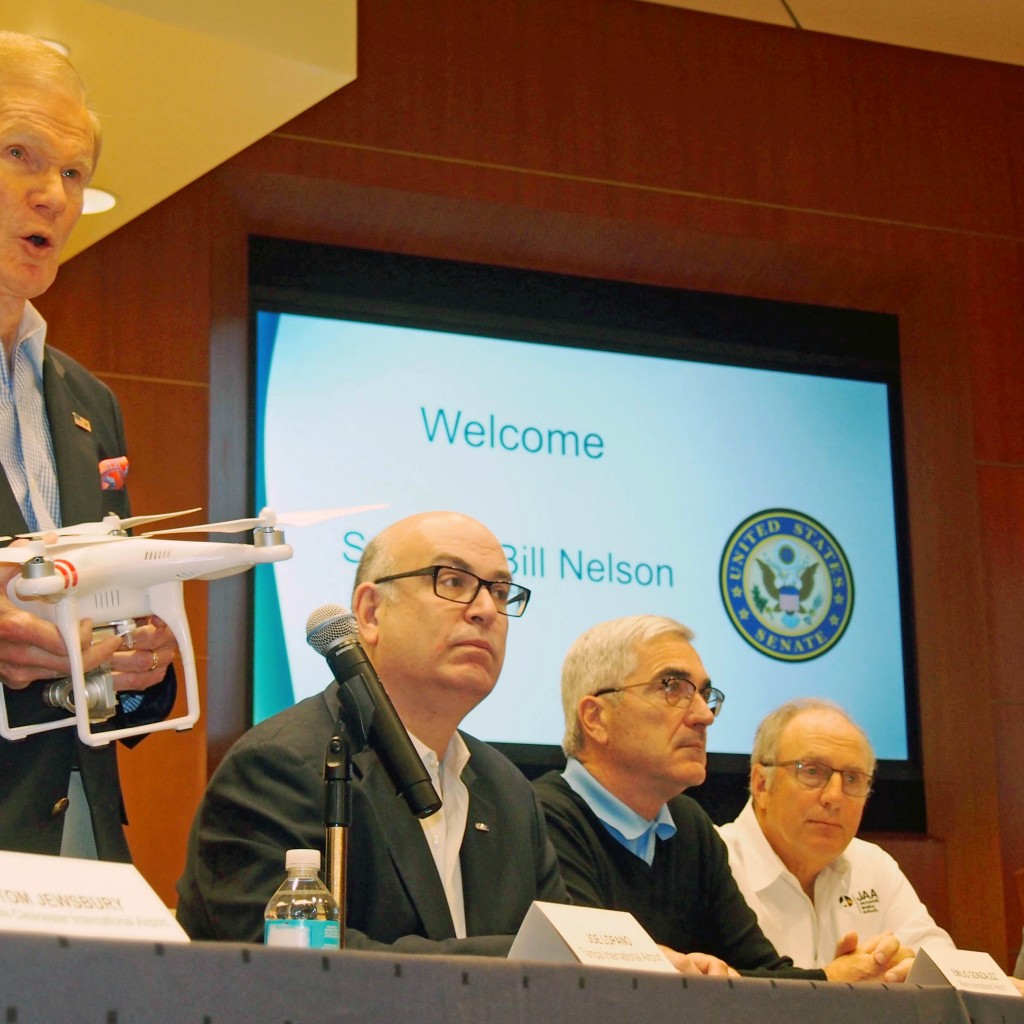
U.S. Sen. Bill Nelson says drones near airports “an accident that is waiting to happen,” and is asking the FAA for tougher rules and to consider technologies allowing airports to take control of drones flying nearby.
Nelson called a meeting at Orlando International Airport Friday of top executives at seven of Florida’s largest airports — Orlando, Miami, Tampa, St. Petersburg-Clearwater, Jacksonville, Sarasota-Bradenton and Northwest Florida Beaches — as well as Kevin Burke, president of the Airports Council International-North America. Each agreed that hobby drones are quickly becoming a threat to airliners.
All in attendance compared the risk to that of birds striking planes. While birds rarely cause crashes, it does happen. They also added a future danger of terrorism.
Federal law already forbids drones flying within five miles of airports. But both Miami International Director Emilio Gonzalez and Sarasota-Bradenton International President Rick Piccolo said there were recent incidents of near-misses between drones and planes. Burke added that it was becoming an increasing problem at airports throughout the country.
“This,” Nelson said, holding up a drone, “is an accident waiting to happen.
“The threat of these things [is] if it gets sucked into a jet engine or if it happens to hit an aircraft, particularly an aircraft that is smaller in size, they cannot take it,” he said.
Federal law and FAA regulations do not offer enforcement powers, Gonzalez said, leading Miami-Dade County to enact drone laws that do.
“The last thing we want is something inadvertent to happen at an airport. Not to mention the human loss which could be catastrophic, but the economic loss could be huge,” Gonzalez said.
Greater Orlando Aviation Authority Executive Director Phil Brown said Orlando would have to look at similar moves.
Other options are limited.
Nelson said he talked to the FAA about what enforcement power it would need. He also asked the agency to look into technologies it might offer airports, because, he suggested, accidents could be caused by someone unfamiliar with the law and not considering the risks, or not competent enough to control the drone, even a child.
One technology Nelson said is being explored could give airports, and other areas of restricted airspace, the power to monitor drone radio frequencies and take control of any drones that enter or approach the air space, and then steer them away.
Nelson said it could include airspace over non-airports such as Kennedy Space Center, military installations, and government buildings. Walt Disney World also has restricted air space.
Another idea he said may be explored would require manufacturers to install software that would keep drones from flying into restricted airspace.
The airport leaders’ said the concern is growing rapidly as drone sales reach millions and the devices become bigger, faster and capable of flying higher and farther every year.
“We have a situation here where technology is out front of regulation, and this truly is a national issue that can only be solved with a system of regulation,” said Jacksonville International Airport CEO Steve Grossman. “And I worry about other aspects of this … with the sophistication of terrorists in this day and age, who’s to say that is not a threat as well?”




2 comments
Michael Blitch
February 6, 2016 at 10:06 am
Federal law certainly does NOT prohibit the use of UAS (they are not ‘drones’ as no aviation authority in the world, including the FAA) uses that term.
Have you actually look at the reports and what they entail. None of them definitively identy a UAS but are ‘sightings’ akin to the old ‘UFO’ reports. A sighting is not a ‘near-hit’.
Steve Mann
February 7, 2016 at 11:05 am
This is messed up on so many levels! Typical fear mongering and catering to the paranoid. The panic, here, is completely out of any sort of proportion to reality.
There is absolutely no factual evidence to support the fear and ignorance around small personal drones. There have been more than a million hours of flight of small drones, yet there is not one verifiable report of a drone crash in the US that resulted in a serious injury as defined by the NTSB to someone not connected to the flight. Not one. (A Band-Aid is not a serious injury- See CFR 49 §830.2). It is a safety rate that all other segments of aviation would be jealous to have. There is also not one verifiable report of a collision between a small drone and a manned aircraft. Not one. An FAA executive speaking to a nervous audience of helicopter operators at HAI Heli-Expo in Orlando (March 2015) and said that while there’s never been a reported contact between an sUAS and a civilian aircraft, the military has some experience in that regard. In all cases the aircraft was virtually unscathed while the UAS was “smashed to pieces.”
Small UAVs do not pose any significant risk to anyone. “Dangerous” and “invasion of privacy” concerns are ridiculous, driven by paranoia borne of ignorance and propagated by lazy, irresponsible reporting. Where’s the blood and mayhem to justify the perception that small personal drones are a threat to public safety?
Comments are closed.